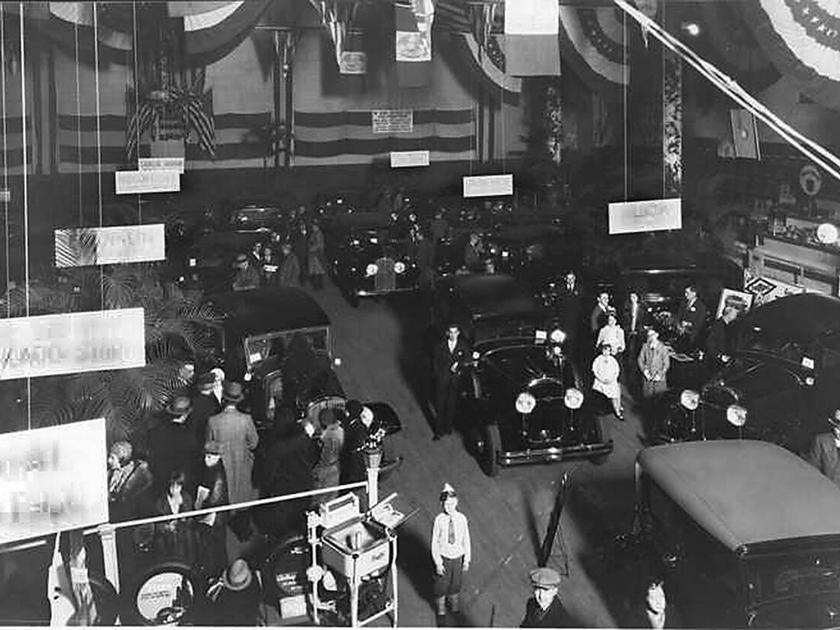KLASEY: 1935 Kankakee Auto Show | Local News
In early 1935, the “light at the end of the tunnel” seemed to brighten for the weary citizens of the Kankakee region depression.
Almost six years after the stock market crash of 1929, jobs were slowly becoming available to the unemployed, and more and more customers were spending money in local stores.
A major sign of heightened optimism about the local economy was a headline in the February 8, 1935 edition of the Kankakee Republican-News: “Car Dealers Plan Big Show for Four Days”. Sponsored by the Kankakee County Automobile Dealers Association, the event would feature more than 40 new cars presented by 24 dealers from Kankakee, Herscher, Manteno, Momence, Reddick and St. Anne.
The show would take place from February 28 to March 3 in the National Guard Armory at 150 N. Indiana Ave.
The Armory, built in 1923, was Kankakee’s largest indoor site for events such as the auto show.
“The spacious, recently completely refurbished armory will be beautifully decorated as a background for the latest automotive designs, which are particularly attractive this year,” noted the Republican-News in its February 26 edition, which included a special Auto from 12 pages. Show section.
“Auto dealers expect their business to boom soon,” the newspaper observed, “anticipating that the thousands of used cars on the highways will be replaced by new and shiny ones as business conditions, in general, continue to deteriorate. straighten up, and this big auto show was expected in anticipation of the boom.
The dealers painstakingly decorated the interior of the armory and added an amateur entertainment contest, “to make the event attractive, entertaining and interesting, not just a colorless display of merchandise.”
Local artists were encouraged to register and compete for cash prizes.
The star of Thursday’s opening night was “an old-fashioned fiddler competition”; Friday was devoted to harmonica players.
The Saturday competition offered various forms of musical entertainment, both vocal and instrumental, for individual and group performances.
Sunday’s final show would consist of performances that had won competitions on the previous three nights.
The Auto Show was open from 1 p.m. to 10 p.m. each of the four days, with musical performances starting at 8:15 p.m.
There was a small entrance fee, which did not seem to affect attendance (the newspaper reported “record crowds”, compared to those at smaller scale auto shows held in 1933 and 1934).
Some of the cars on display at the show bore familiar nameplates – Buick, Cadillac, Chevrolet, Chrysler, Dodge and Ford – but others are only visible today in the rearview mirror of history.
They included Auburn, DeSoto, Graham, Hudson, LaFayette, LaSalle, Nash, Oldsmobile, Packard, Plymouth, Pontiac, Studebaker and Terraplane.
The Republican-News Auto Show section was filled with advertisements from local car dealers.
“You are welcome to inspect the new Master DeLuxe Chevrolet, Aristocrat of Low Price Cars,” proclaimed Key City Chevrolet, whose showroom was located at 354 S. Schuyler Ave.
Hodak Motor Sales, located at 256 E. Station St, announced the Studebaker Champion’s new “Miracle Ride” suspension with the slogan: “The greatest pleasure in the world is to own a Champion.”
The Packard Motor Car Co. purchased a quarter-page advertisement announcing that Yeates & Betourne, at 100 W. Court St., had been appointed the Kankakee dealership.
The announcement indicated that the new five-passenger Packard 120 sedan would be shown at the Auto Show. The sedan, delivered to Kankakee, would cost $ 1,221 fully equipped.
Given the economic conditions at the time, most dealerships focused on their vehicles at a low price.
George Fortin, located at 421 N. Chicago Ave., offered the LaFayette sedan (“Beautiful car from the low-cost realm”) starting at $ 585.
Jeffers & McBroom, on the south side of town at 830 Main Street, sold Hudson and Terraplane automobiles. The Terraplane sedan sold for $ 585; paying an additional $ 110 allowed the buyer to upgrade to a Hudson Six sedan.
The lowest price in the special section was announced by dealer Romy Hammes on Indiana Avenue (“across from the courthouse”).
The Ford and Lincoln dealership posted a price of $ 495 for a Ford V-8 sedan.
“Here is a car – inexpensive, economical to use, yet built to meet all the needs of the modern automobile,” the ad said.
By today’s standards, prices seem ridiculously low … until you realized that in 1935, the average factory worker was making 55 cents an hour ($ 22 for a week 40 hours), or $ 1,144 per year.
Apparently, the idea for the auto show was a success.
On Saturday March 2, the Republican-News reported that members of the sponsoring car dealership group “are signaling considerable public interest in the beautiful new cars on display and report that a number of sales have been made from the ground up.” . A state report published in 1936 showed that auto sales in Kankakee for the year 1935 were over $ 2 million.

